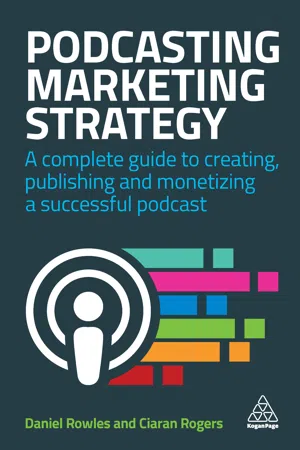
Podcasting Marketing Strategy
A Complete Guide to Creating, Publishing and Monetizing a Successful Podcast
- English
- ePUB (mobile friendly)
- Available on iOS & Android
Podcasting Marketing Strategy
A Complete Guide to Creating, Publishing and Monetizing a Successful Podcast
About this book
Take advantage of the skyrocketing popularity of podcasts and learn how your business can use the unique opportunity to stand out and drive loyal engagement with target audiences, using this complete guide to podcast marketing - written by the hosts of the global top ten iTunes podcast, The Digital Marketing Podcast. Podcasting is a hugely persuasive, yet under-utilized channel accessed by an affluent and influential demographic. In a crowded and noisy digital environment, it gives organizations, brand builders and marketers the unique opportunity to stand out and drive engagement with target audiences, with accurate and measurable levels of allegiance that can only be dreamed of on other digital channels.This book is the complete guide to the podcast environment. It describes the importance of podcasting for businesses and explains why, uniquely, it has the highest level of consumer commitment than any other social media. Written by award-winning author Daniel Rowles, and his co-host of the global top ten iTunes podcast, The Digital Marketing Podcast, this book: -Explains how podcasting can drive business results
-Advises on how to record, edit, and advertise your content
-Provides a unique digital marketing toolkit
-Is supported by case studies from influential organizations around the globeQuite simply, Podcasting Marketing Strategy is the definitive authority to making and publishing podcasts that deliver quantifiable results.
Frequently asked questions
- Essential is ideal for learners and professionals who enjoy exploring a wide range of subjects. Access the Essential Library with 800,000+ trusted titles and best-sellers across business, personal growth, and the humanities. Includes unlimited reading time and Standard Read Aloud voice.
- Complete: Perfect for advanced learners and researchers needing full, unrestricted access. Unlock 1.4M+ books across hundreds of subjects, including academic and specialized titles. The Complete Plan also includes advanced features like Premium Read Aloud and Research Assistant.
Please note we cannot support devices running on iOS 13 and Android 7 or earlier. Learn more about using the app.
Information
Podcasting in perspective
Stand out from the social media noise
The growth of podcasts
The barrier to entry
Podcast passion
People who like podcasts, really really like podcasts.
Content or channel
The podcast opportunity
PODCAST INSIGHTS Podcast inspiration
Table of contents
- Foreword
- Part One Podcasting in perspective
- 01 Stand out from the social media noise: why you should be podcasting
- 02 Podcast adoption: growth and expansion of podcasting as a popular medium
- 03 Understanding how people really listen to and absorb audio content
- 04 Building genuine personal engagement through podcasting
- Part Two Building your business case and plan
- 05 How to use podcasts to drive business results
- 06 Understanding the role of podcasts in the user journey
- 07 An introduction to podcast marketing
- 08 What differentiates a great podcast?
- 09 What is digital branding and how does business development fit in?
- 10 Defining your content plan and using content calendars
- 11 Driving action from podcasts
- Part Three Building your podcast and making it a success
- 12 The importance of landing pages and show notes (and getting SEO right)
- 13 Defining your podcast audience and content
- 14 Understanding and selection of different podcast formats
- 15 Preparing your podcast recording environment
- 16 Choosing your recording hardware and software
- 17 An overview of podcast editing options and how to do it
- 18 Using interviews with influencers to maximize your podcast strategy
- 19 Show branding intros and outros: making the right first impression
- 20 Podcast advertising and monetization: where to begin and how to manage
- 21 Publishing and distributing your podcast
- 22 Measuring success: tapping into how and why people listen to your podcast
- 23 The podcast marketing toolkit
- 24 The value of web analytics: measuring the impact of your podcast activity
- Part Four The future of podcasting
- 25 Where next for podcasting? Conversational design, artificial intelligence and machine learning
- 26 Future-proofing your podcast strategy for the ever-changing user journey
- Index